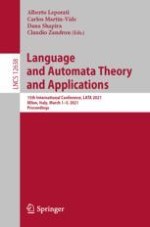2021 | OriginalPaper | Chapter
State Complexity of the Set of Synchronizing Words for Circular Automata and Automata over Binary Alphabets
Author : Stefan Hoffmann
Published in: Language and Automata Theory and Applications
Publisher: Springer International Publishing
Activate our intelligent search to find suitable subject content or patents.
Select sections of text to find matching patents with Artificial Intelligence. powered by
Select sections of text to find additional relevant content using AI-assisted search. powered by
